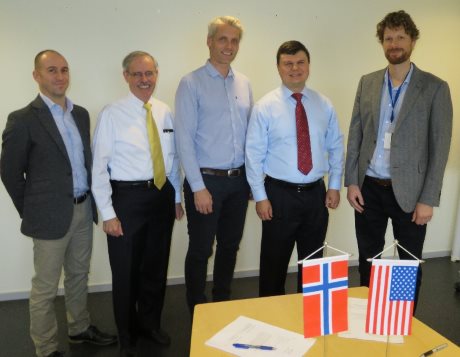Lightbridge fuel moves towards irradiation testing
17 October 2017
Lightbridge Corporation has signed orders with the Institute for Energy Technology (IFE), operator of Norway's Halden research reactor, for the design and fabrication of a second irradiation rig for testing of its fuels. The IFE is already manufacturing a first test rig ready for irradiation testing of Lightbridge's fuel samples in the reactor.
 |
| IFE and Lightbridge teams at IFE facilities in Halden following the signing of the new task orders (Image: Lightbridge) |
Reston, Virginia-based Lightbridge plans to conduct full irradiation testing of fabricated fuel samples under commercial reactor operating conditions in a pressurised water loop at the Halden reactor. The company said yesterday it is making progress towards the start of irradiation testing, and has recently inspected hardware components manufactured by the IFE for the first irradiation rig.
The first irradiation rig will host a four-rod bundle of Lightbridge's four-lobe fuel rods and will be placed into the reactor. Its design allows removal of partially irradiated rods and insertion of new rods to enable early collection of data from post-irradiation examination.
The second irradiation rig, for which Lightbridge and the IFE have now signed task orders, will be designed to constrain the radial expansion of the four-rod bundle to simulate conditions inside an actual commercial fuel assembly.
Lightbridge CEO Seth Grae said testing of fuel samples in the Halden reactor would be an important milestone for bringing its fuel technology to market. "The irradiation testing program is being structured at the Halden reactor and US commercial nuclear plants in parallel to demonstrate operation of the first Lightbridge fuel rod in a commercial reactor in the US as soon as 2021," he said. The company has previously said irradiation testing is expected to begin in the Halden reactor this year.
Lightbridge's advanced metallic fuel is made from a zirconium-uranium alloy and uses a unique composition and fuel rod geometry, which, the company says, enables it to operate at a higher power density than uranium oxide fuels in use today. The company holds numerous patents from countries including Canada, China, Japan, Russia, South Korea and the USA, as well as European patents.
The company recently signed a binding agreement with North American Areva NP (Areva Inc) to set up a 50:50 joint venture to be the exclusive vehicle through which the companies will research, develop, demonstrate, fabricate, license, market and sell fuel assemblies using Lightbridge's proprietary metallic fuel designs and other advanced nuclear fuel intellectual property contributed by both companies.
IFE president Nils Morten Huseby said the institute has over the past two years been working closely with Lightbridge in preparation for the irradiation testing. "Nuclear power plants benefit from R&D advances and related technical solutions, which is why Halden's strong international profile and solid technical basis is such an asset for the nuclear community," he said.
The Halden reactor is a 25 MWt boiling heavy water reactor built into a rock hillside on the north bank of the river Tista in south-east Norway. Used as a tool to investigate nuclear fuels and materials, the reactor's loop systems can simulate the conditions found inside commercial pressurised water reactors and boiling water reactors. The Halden Project, established in 1958, is a joint undertaking of national organisations from 19 countries who sponsor the jointly financed programme under the auspices of the OECD-Nuclear Energy Agency. The reactor started up in 1959.
Researched and written
by World Nuclear News